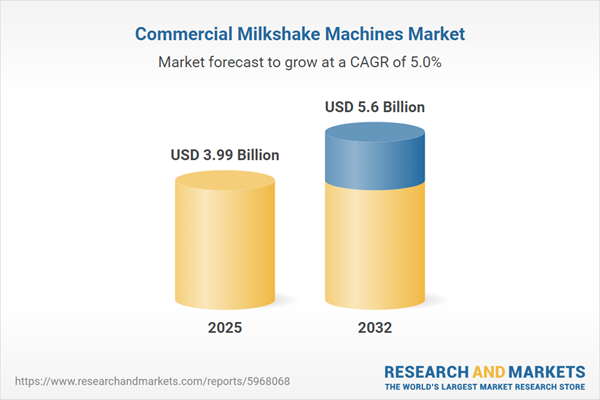Speak directly to the analyst to clarify any post sales queries you may have.
The commercial milkshake machines market is evolving rapidly, shaped by innovation, shifting consumer trends, and heightened regulatory requirements. Senior decision-makers face a landscape where agility, technology, and sustainability now define operational excellence and competitive advantage.
Market Snapshot: Commercial Milkshake Machines Market Growth
The commercial milkshake machines market grew from USD 3.80 billion in 2024 to USD 3.99 billion in 2025 and is projected to reach USD 5.60 billion by 2032, representing a CAGR of 4.97% during the forecast period.
Scope & Segmentation
This report offers comprehensive coverage of the commercial milkshake machines market, analyzing trends, opportunities, and market dynamics across core segments.
- Machine Types: Countertop and floor standing units address diverse operational layouts and capacity needs.
- End Users: Cafes and coffee shops, hotels and resorts, ice cream parlors, quick service restaurants, and retail hypermarkets & supermarkets represent the primary buyers, each with unique performance and integration priorities.
- Sales Channels: Operators deploy direct sales relationships, work with distributors or dealers, and leverage online retail, including company websites and e-commerce platforms.
- Capacity Categories: High, medium, and low-capacity models support a range of throughput requirements, aligning investment with service frequency.
- Technology Options: Automatic, manual, and semi-automatic systems offer varying degrees of control and programming.
- Power Sources: Electric and gas-powered machines enable flexible deployment across infrastructure profiles.
- Regions Covered: The Americas; Europe, Middle East & Africa; and Asia-Pacific are analyzed, with deep dives into key national markets and their regulatory context.
- Leading Companies: Analysis includes Hamilton Beach Brands, Vita-Mix Corporation, Blendtec, Conair Corporation, Nemco Food Equipment, Middleby Corporation, T&S Brass & Bronze Works, Ali S.p.A., Breville Group, and Royal Appliance Manufacturing.
Key Takeaways for Strategic Decision-Makers
- Customization capabilities in commercial milkshake machines are in higher demand as consumers seek health-conscious or personalized formulations. Sr. executives should prioritize flexible machine architectures.
- Digital connectivity has become integral, enabling operators to optimize machine uptime, monitor usage, and improve maintenance planning remotely.
- Growing sustainability expectations are driving the adoption of energy-efficient components and eco-friendly refrigerants, which are increasingly baseline requirements.
- Foodservice venues now expect integration with POS systems and other digital workflows, fueling investment in automated and modular machines that can adapt to changing menu trends.
- Service models are evolving as operators value performance-based contracts, predictive maintenance, and local technical support to minimize disruptions and extend asset lifecycles.
- Regional market strategies are necessary, particularly in Asia-Pacific and Europe, where local regulation and consumer expectations create distinct equipment and service requirements.
Tariff Impact and Supply Chain Resilience
New United States tariffs introduced in 2025 have prompted global and domestic equipment manufacturers to reevaluate sourcing strategies, shifting toward localized assembly or alternative trade partners. This has increased unit prices and supply chain complexity, leading operators to emphasize cost-of-ownership analysis, prioritize long-term service partnerships, and pursue supply chain diversification to maintain reliable operations.
Methodology & Data Sources
Insights are grounded in primary interviews with industry executives, operational managers, and end users across segments. Secondary research includes industry reports, regulatory documents, and technical literature, with data triangulation and expert review ensuring validity and comprehensive coverage.
Why This Report Matters
- Enables senior leaders to anticipate market shifts, respond to emerging consumer and regulatory trends, and benchmark equipment investments for differentiation and profitability.
- Provides actionable intelligence on regional dynamics, tariff impacts, and service innovations, supporting evidence-based decisions in procurement and operational strategy.
- Equips organizations with segmented insights into technology adoption, capacity planning, and supply chain management for sustained leadership in the commercial milkshake machine market.
Conclusion
The commercial milkshake machines market is defined by evolving technologies, regulatory requirements, and diverse regional dynamics. Strategic adaptability, operational efficiency, and targeted innovation will distinguish successful market participants in the years ahead.
Additional Product Information:
- Purchase of this report includes 1 year online access with quarterly updates.
- This report can be updated on request. Please contact our Customer Experience team using the Ask a Question widget on our website.
Table of Contents
3. Executive Summary
4. Market Overview
7. Cumulative Impact of Artificial Intelligence 2025
Companies Mentioned
The companies profiled in this Commercial Milkshake Machines market report include:- Hamilton Beach Brands, Inc.
- Vita-Mix Corporation
- Blendtec, LLC
- Conair Corporation
- Nemco Food Equipment Company, LLC
- Middleby Corporation
- T&S Brass & Bronze Works, Inc.
- Ali S.p.A.
- Breville Group Limited
- Royal Appliance Manufacturing Co.
Table Information
| Report Attribute | Details |
|---|---|
| No. of Pages | 198 |
| Published | October 2025 |
| Forecast Period | 2025 - 2032 |
| Estimated Market Value ( USD | $ 3.99 Billion |
| Forecasted Market Value ( USD | $ 5.6 Billion |
| Compound Annual Growth Rate | 4.9% |
| Regions Covered | Global |
| No. of Companies Mentioned | 11 |









